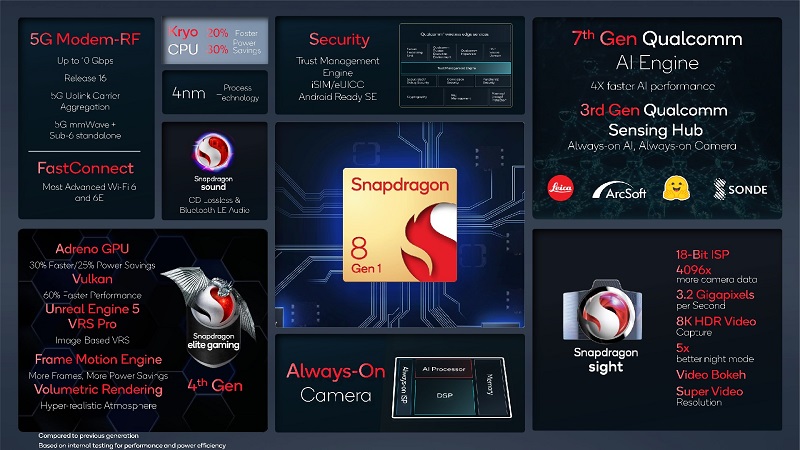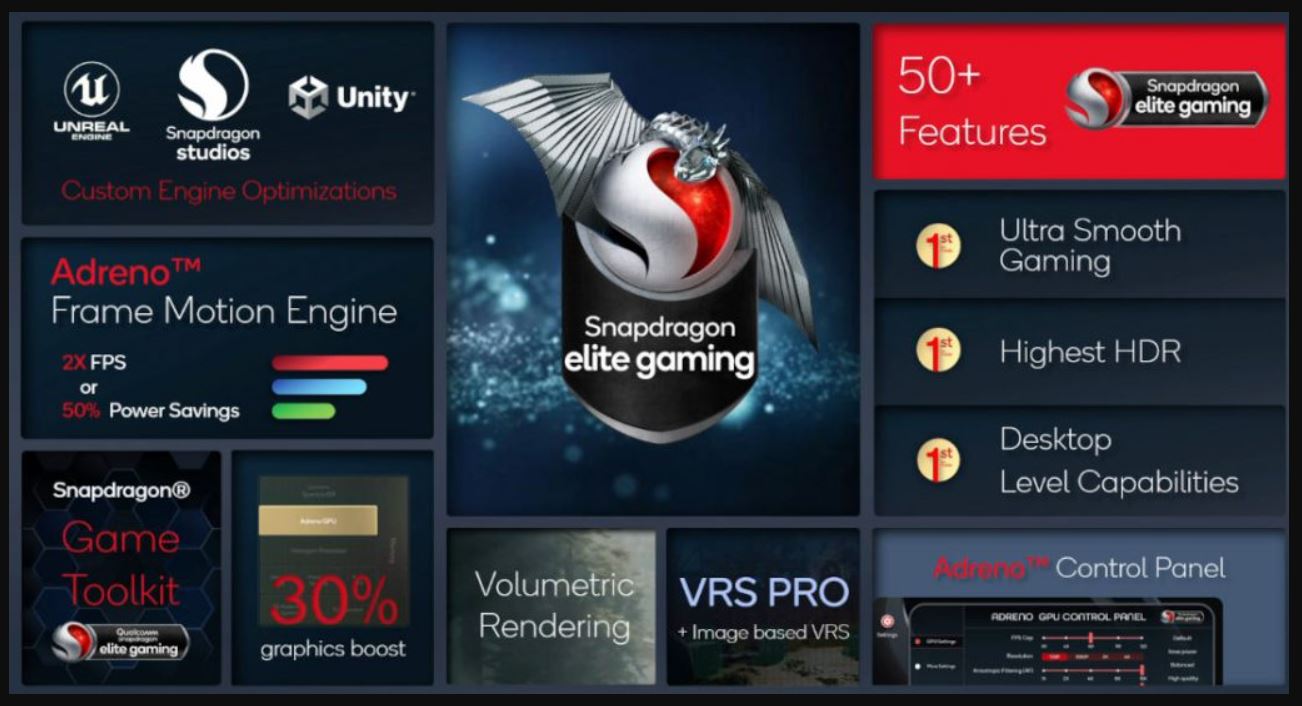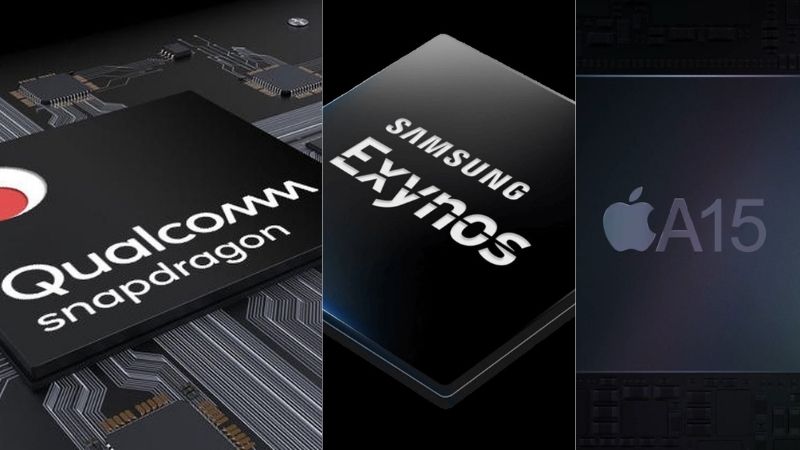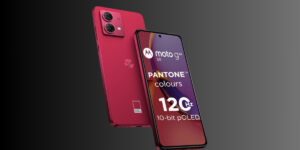Qualcomm’s Snapdragon 888+ 5G chipset was introduced only a few months ago. The Xiaomi Mi Mix 4 was the first smartphone with an 888+ processor. The Qualcomm Snapdragon 888+, on the other hand, does not represent a significant boost. It still has throttling and heating difficulties due to the high-performance Cortex X series CPU, which has an indirect or direct impact on the device’s performance. Fans have high hopes for the forthcoming Qualcomm Snapdragon 8 Gen 1 5G processor. Qualcomm has addressed the throttling and performance concerns with the latest Snapdragon 8 Gen 1 5G processor. Will it perform better than the Exynos 2200 and recently announced Apple A15 Bionic chip? Let’s find out.
Snapdragon 8 Gen 1 vs Exynos 2200 vs Apple A15 Bionic
CPU
Snapdragon 8 Gen 1 comes with combination of 1x 3.0GHz (Cortex-X2), 3x 2.5GHz (Cortex A710) and 4x 1.8GHz (Cortex A510). Exynos 2200, on the other hand, features ARM’s new CPU cores (Similar to SD 8 Gen 1), i.e., single Cortex-X2, three Cortex-A710s, and four Cortex-A510s. As per Geekbench data, the frequency combination for Exynos 2200 is 1× 2.80GHz + 3× 2.52GHz + 4× 1.82GHz. With Apple’s A15 Bionic, we see 6-cores with a 2+4 configuration. The first two cores are aimed at high performance, while the remaining four cores are assigned for power efficiency. A15’s Maximum frequency is 3.23GHz.

GPU
Snapdragon 8 Gen 1 packs next-generation Adreno GPU (730?) with Snapdragon Elite Gaming while Exynos 2200 features Samsung Xclipse 920 GPU based on AMD’s RDNA 2. With A15 Bionic, we see up to a 5-Core GPU that offers a 50% faster graphics processing unit than the competition.

Regarding GPU performance, the Snapdragon 8 Gen 1 looks to fall short of its two main competitors, the Exynos 2200 and the Apple 15 Bionic. The Snapdragon 8 Gen 1 chipset achieves 158.4 frames per second on Manhattan 3.1, 112.7 frames per second on Aztec Normal, and 43.1 frames per second on Aztec High. In comparison, the Exynos 2200 clocked 170.7 FPS, 121.4 FPS, and 51.5 FPS in early testing, while the A15 Bionic passed the Manhattan 3.1 test at 198 FPS. This is a 7.2% deficit when compared to the Exynos 2200 and a 20% disadvantage when compared to the A15 Bionic.
| Chipsets | Manhattan 3.1 (Early Test) | Test Report |
| Snapdragon 8 Gen 1 | 158.4 FPS |
|
| Exynos 2200 | 170.7 FPS |
|
| Apple A15 Bionic | 198 FPS |
|
Peak performance isn’t the sole metric, though. Sustained performance is more essential, and it looks like Qualcomm outperforms its competitors in this area owing to less throttling. When compared to the Exynos 2200, Front Tron claims that this should provide equal sustained performance. Under continuous loads, the Exynos 2200 and A15 Bionic experience performance reductions of around 25% and 35%, respectively, according to Qualcomm’s statistics. In comparison, the Snapdragon 8 Gen 1 is expected to throttle by about 20%.
Benchmark Test
Talking about the Geekbench 5 benchmark test,
- The A15 bionic-powered iPhone 13 Pro Max has scored 1734 points in the single-core while on the multi-core test, the highest score recorded is 4818 points.
- The Snapdragon 8 Gen 1 powered Galaxy S22 Ultra has achieved up to 1226 points for single-core and 3462 points for multi-core.
- The Exynos 2200-powered Galaxy S22 Ultra has scored 1109 points for single-core and 3534 points for multi-core.
Specifications Comparison Table
| Snapdragon 8 Gen 1 | Exynos 2200 | A15 Bionic |
| 4nm EUV (Samsung) | 4nm EUV (Samsung) | 5nm 2nd Gen (TSMC) |
| 1x Cortex-X2 @ 3.0GHz 3x Cortex-A710 @ 2.5GHz 4x Cortex-A510 @ 1.8GHz |
1x Cortex-X2 @ 2.8GHz 3x Cortex-A710 @ 2.5GHz 4x Cortex-A510 @ 1.8GHz |
2x Avalanche @ 3.23GHz 4x Blizzard @ 1.8GHz |
| Adreno 730 @ 818MHz | Xclipse 920 (AMD RDNA 2) | 5-core GPU |
| 4K @ 120Hz, QHD+ @ 144Hz | 4K @ 120Hz, QHD+ @ 144Hz | Computational Photography
Cinematic Mode |
| Upto 200MP 108MP at 30FPS 64MP+36MP at 30FPS |
Upto 200MP 108MP at 30FPS 64MP+32MP at 30FPS |
Apple ISP |
| Integrated 5G Modem mmWave/Sub-6GHz Support Up to 10Gbps Download Up to 3.67Gbps Upload |
Integrated 5G Modem mmWave/Sub-6GHz Support Up to 10Gbps Download Up to 3Gbps Upload |
Qualcomm X60 5G Modem |
| LPDDR5, UFS 3.1 | LPDDR5, UFS 3.1 | LPDDR4X, NVMe |
Having that said, what do you think about the latest Qualcomm Snapdragon 8 Gen 1 5G chipset, and Do you think it will be able to compete with Samsung Exynos 2200 and Apple A15 Bionic chipset? Do let us know by dropping a comment in your words below.












